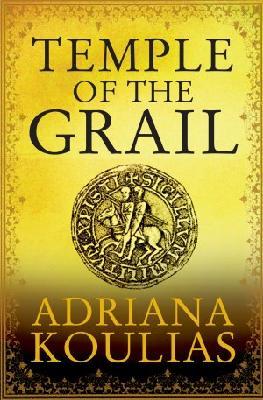
- Free Article: No
- Contents Category: Fiction
- Review Article: Yes
- Article Title: Generic Difficulties
- Online Only: No
- Custom Highlight Text:
These two quite different historical novels, both by first-time novelists, reveal once again the many difficulties of that genre, no matter how much information the author has gathered. The publisher of Temple of the Grail has provided ample publicity material. Along with the usual media release, there is a two-page puff piece couched in the first person about how Adriana Koulias came to write and publish the book. Koulias is Brazilian by birth, from a Catholic family that moved to Australia when she was nine: ‘By the time I was eighteen I had come into contact with a cornucopia of religion and philosophy.’ Much of this lore has been fed into Temple of the Grail, which sets out, she says, ‘to show how religious zeal, carried to extremes, eventually leads to error’. In addition to this promotional material, the book itself contains a foreword by David Wansbrough praising the book to the skies:
- Book 1 Title: Leavetaking
- Book 1 Biblio: Ginninderra Press, $24.00pb, 260pp
- Book 1 Cover Small (400 x 600):

- Book 1 Cover (800 x 1200):

- Book 2 Title: Temple of the Grail
- Book 2 Biblio: Picador, $30.00pb, 448pp
- Book 2 Cover Small (400 x 600):

- Book 2 Cover (800 x 1200):

Temple of the Grail has two components. The most prominent follows that rather tired formula, the Medieval Monastic Murder Mystery. The sequence of events is often muddy and the detective, a Templar Knight, does not help his squire (the ingenuous narrator) or the reader understand the train of his investigation. It is not surprising to discover, as Koulias states in her blurb: ‘It didn’t start out as a murder mystery ... In fact, I didn’t know who the killer was myself until the end!’ If the writer is confused, the reader is scarcely likely to be less so. And to emphasise the point about religious zeal. she brings the Inquisition along for the ride, with a predictably sadistic Inquisitor in charge.
The other element in this novel is the mystical. Koulias is a student of Esoteric Science and aims to illustrate the harmony of body, soul and spirit. There is a mystery beyond that of the murders being committed in the monastery, high in the mountains of Languedoc, in 1254. The young narrator, Christian de Saint Annand, has dreams and visions that culminate in a mystical revelation, which left this reader puzzled; and the framing device of the book, a short prologue and even shorter epilogue, provides no clarification. Perhaps studying Esoteric Science would help.
The novel does have several redeeming features. The main character – the boy Christian and his master Andre, son of a crusader and an Alexandrian woman – have depth and their relationship is convincing. Andre is gruff, short-tempered and, Christian suspects, not entirely free of heretical leanings, though he is fond of him nonetheless. Among all the superstitious and mystical flummery that proliferates in the medieval setting, Andre provides a welcome grounding in intelligence and reason without being too anachronistic, though my sense of intellectual history was jolted when Christian was prompted to announce: ‘So when translating one cannot escape the distortions produced by one’s culture?’ The setting is also quite well realised. Koulias has help-fully provided a plan of the monastery at the front. Architecture, clothing, weather and all such details are worked into the narrator’s subjective experience in a natural way.
Temple of the Grail was self-published in 2001 after being rejected by several publishers and has now been picked up by Picador, no doubt because it has already demonstrated its marketability. Its combination of mystery and mysticism give it a good chance of building on this success.
I cannot predict such a happy future for Joy Hooton’s Leavetaking . With its mawkish front cover, showing a clumsily drawn young woman standing in the snow, and its theme of ‘freedom fighters’ who might with a very slight change of perspective be seen as terrorists, it does not seem to be marked out of best-seller status.
Hooton provides her own foreword to Leavetaking, explaining its historical basis in the French Canadian rebellions against the British in 1837 and 1838. An earnest tone is established straight away and never lets up. The hero, one Michel Caseneuve, is a minor leader in the rebellion and lives through all the predictable stages of enthusiasm, romance, doubt, punishment – transportation to New South Wales – and so on. There are long, dreary recitations of events by other characters, spoken in stilted, unnatural prose.
The language of the third-person narrator is at times so strange that I began to wonder whether Hooton was deliberately trying to represent francophone speech, although there isn’t a particularly French flavour to the prose. ‘Just then, there was a large thumping on the front door’: ‘large’ is an odd choice of adjective here. The clumsiness of the syntax occasionally leads to ludicrous errors: ‘he was being herded down a long corridor and into a small cell at the back of another man.’ Surely no French speaker would come up with this kind of glaring non sequitur, even in English. A few attempts at colourful language stand out uncomfortably: ‘You’re as welcome as a maiden’s monthly, Michel,’ declares one of the rough-diamond characters, leaving us to ponder the incongruity, ambiguity and plain bad taste of such an expression from someone who is being presented to us as a heroic leader.
Hooton’s narrative never engages the reader’s imagination. Some opportunities for colour and immediacy are spectacularly missed: at one point ‘the men were in good spirits, chaffing each other humorously’, while later they are linking arms and ‘joining ... in a rousing song’. So we are told, but we don’t see it. The characters are all composed of cardboard, and events and emotions are totally predictable. Michel is even subjected to a ‘good cop/bad cop’ routine during his interrogation.
Any author, no matter how experienced, needs a good editor. Koulias has had the help of professionals. Since reading the uncorrected review copy of Temple of the Grail, I have had the opportunity to see the final product, and the difference is remarkable. Hooton’s small independent publisher, however, has not given her that advantage. Given her background as a critic and bibliographer, Leavetaking is surprisingly sloppy, with punctuation mistakes and misused words. In her foreword, she lists ‘numerous friends’ who read the manuscript. Did none of them notice the inconsistencies, faulty sentence construction and malapropisms? These all irritate reader and interrupt the flow of the prose. Neither of these books is brilliant enough to rise above the trivial distractions of such easily corrected errors: Koulias is lucky to have found a publisher that maintains a basic standard in editorial practice.


Comments powered by CComment